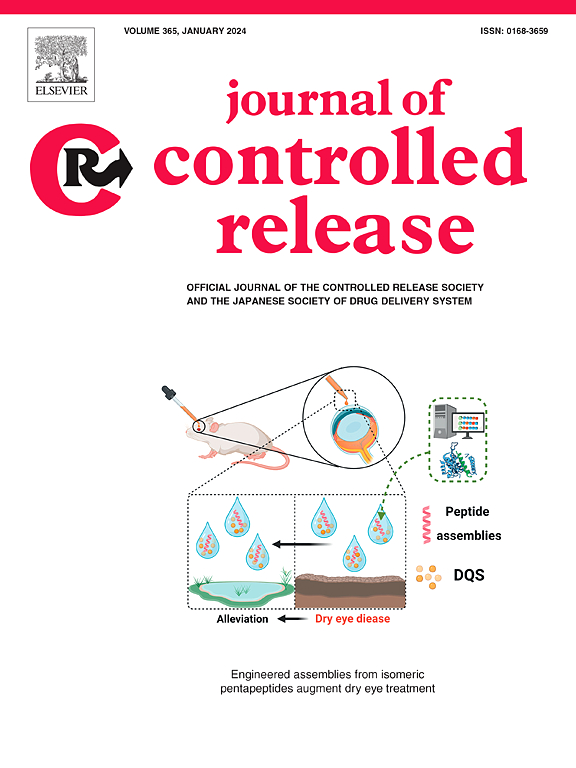用于增强乳腺癌化疗药物输送的双响应纳米粒子。
IF 10.5
1区 医学
Q1 CHEMISTRY, MULTIDISCIPLINARY
引用次数: 0
摘要
由于肿瘤环境中存在致密的胶原屏障,给药效率往往会影响化疗效果。在此,我们报告了一种能够实现 pH 和谷胱甘肽双响应给药的纳米粒子,以提高乳腺癌化疗的疗效。我们合成了马来酰亚胺化聚乙二醇和聚乳酸嵌段共聚物作为核心材料,并通过自组装将多柔比星封装到纳米粒子中。通过点击化学将硫代胶原酶和马来酰亚胺连接到纳米粒子表面,并进一步包覆硫酸软骨素作为保护层,形成双响应多柔比星纳米粒子。结果表明,该纳米粒子能穿透肿瘤深层组织,靶向癌细胞的 CD44,并能在 pH 和谷胱甘肽信号的作用下在癌细胞中释放多柔比星,在乳腺癌小鼠中显示出卓越的抗癌功效。总之,双响应纳米粒子可用作药物载体,在乳腺癌化疗中增强给药效果。本文章由计算机程序翻译,如有差异,请以英文原文为准。
Dual-responsive nanoparticles for enhanced drug delivery in breast Cancer chemotherapy
Drug delivery efficiency often affects chemotherapy outcome due to dense collagen barrier in tumor environment. Here, we report a nanoparticle capable of pH and glutathione dual-responsive drug delivery to enhance the efficacy of breast cancer chemotherapy. Maleiminated polyethylene glycol and polylactide block copolymer were synthesized as a core material, doxorubicin was encapsulated into the nanoparticle by self-assembly. Thiocollagenase and maleimide were connected on the nanoparticle surface by click chemistry, and further coated with chondroitin sulfate as a protective layer to form dual-responsive doxorubicin nanoparticle. The results showed that the nanoparticle had the ability to penetrate deep tumor tissue, to target on CD44 of cancer cell, and to release doxorubicin in cancer cell in response to pH and glutathione signals, demonstrating superior anticancer efficacy in breast cancer-bearing mice. In conclusion, the dual-responsive nanoparticle could be used as a drug carrier to enhance drug delivery in breast cancer chemotherapy.
求助全文
通过发布文献求助,成功后即可免费获取论文全文。
去求助
来源期刊

Journal of Controlled Release
医学-化学综合
CiteScore
18.50
自引率
5.60%
发文量
700
审稿时长
39 days
期刊介绍:
The Journal of Controlled Release (JCR) proudly serves as the Official Journal of the Controlled Release Society and the Japan Society of Drug Delivery System.
Dedicated to the broad field of delivery science and technology, JCR publishes high-quality research articles covering drug delivery systems and all facets of formulations. This includes the physicochemical and biological properties of drugs, design and characterization of dosage forms, release mechanisms, in vivo testing, and formulation research and development across pharmaceutical, diagnostic, agricultural, environmental, cosmetic, and food industries.
Priority is given to manuscripts that contribute to the fundamental understanding of principles or demonstrate the advantages of novel technologies in terms of safety and efficacy over current clinical standards. JCR strives to be a leading platform for advancements in delivery science and technology.
 求助内容:
求助内容: 应助结果提醒方式:
应助结果提醒方式:


